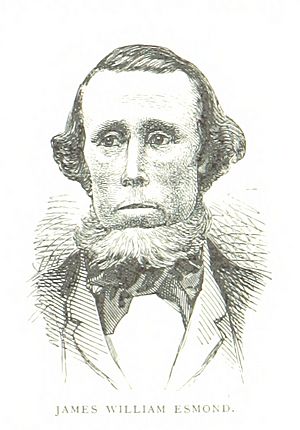James Esmond facts for kids
James William Esmond (born April 11, 1822 – died December 3, 1890) was an Irish-Australian gold seeker and miner. He was one of the very first people to find gold in Australia. His discovery helped start the exciting Victorian gold rush.
Contents
Esmond's Early Life in Australia
James Esmond was born in 1822 in Enniscorthy, a town in County Wexford, Republic of Ireland. His father was a merchant.
In 1840, when he was 18, Esmond moved to Australia. He settled in the Port Phillip District. This area later became the colony of Victoria.
Esmond took on many different jobs. He worked on large farms called stations. These were in the Western Port area. He also drove the mail coach. This coach carried mail from Buninyong to the Wimmera region.
Searching for Gold: Esmond's Adventures
Journey to California and Back
In 1849, James Esmond heard exciting news. There was a huge California gold rush happening. He decided to sail to California to try his luck.
However, he arrived a bit too late to find much gold himself. So, he worked as a supervisor on the gold fields instead. In 1850, he sailed back to Sydney, New South Wales.
On his ship back, he met Edward Hargraves. Hargraves is known for finding gold in New South Wales.
Finding Gold in Victoria
After returning to Australia, Esmond went back to Buninyong. He took a job digging post holes. There, he met Dr. George Hermann Bruhn. Dr. Bruhn was a German doctor and geologist.
Dr. Bruhn had just come from Clunes. He told Esmond that gold had been found there in March 1850. Dr. Bruhn also mentioned that there were quartz rocks in Clunes. These rocks often hold gold.
Esmond decided to check out Clunes. He went with his friend, James Pugh. They looked around and believed there was gold. They hired two sawyers, Burns and Kelly, to help them dig.
The First Victorian Gold Sale
Esmond and his team found several ounces of gold. On July 5, 1851, Esmond traveled to Geelong. He showed the gold to Alfred Clarke. Clarke was a journalist for the Geelong Advertiser newspaper.
At first, Esmond was a bit secretive about where the gold came from. But after buying tools in Melbourne, he told Clarke it was from Clunes. News of his discovery spread quickly. Melbourne newspapers reported it on July 16. The Advertiser shared the news on July 22.
On August 22, Esmond sent 14 ounces of gold to Clarke. This was the first gold from Victoria that was sold. It was later sold in Melbourne.
Why June 28?
Esmond later said he first found gold on June 28, 1851. This date was important. On May 22, 1851, New South Wales had strict rules for gold mining. Miners needed licenses and had to pay fees.
However, Victoria was about to become its own separate colony. This happened on July 1, 1851. From that day, Victoria would make its own rules. Historians think Esmond chose June 28. This way, his claim would reach authorities on July 1. He would then be free from New South Wales' strict rules.
Rewards for Gold Discoveries
In 1853 and 1854, the Legislative Council of Victoria looked into giving rewards for gold discoveries. They considered Esmond's claim. They agreed he found gold on June 28, 1851. They also noted he shared the location on July 22.
But they also looked at Louis Michel's claim. Michel had found gold at Anderson's Creek in Warrandyte. He reported his find on July 5, 1851. This was the same day Esmond showed his gold to Alfred Clarke.
The committee decided Michel was the first to find and announce a goldfield. But Esmond was the first to actually produce gold for sale. Both men were given a reward of £1000.
Continuing His Mining Work
Esmond stayed involved in gold mining. He moved to the goldfields in Ballarat. There, he became a leader among the miners. He even commanded a group of miners during the Eureka Stockade.
In 1865, Esmond started a company. It focused on deep shaft mining north of Clunes. However, his company was not successful. He eventually sold it.
Esmond's Later Years
In his later life, James Esmond faced health issues. He also struggled with money problems. The mining community tried to get government help for him. This help did not come. However, people donated money. They raised £150 for his family.
Esmond passed away on December 3, 1890. This was exactly 36 years after the Eureka Stockade. William Bramwell Withers, a historian, wrote a respectful tribute to Esmond. This was unusual at the time. Many people still saw the Eureka Stockade as a rebellion.
James Esmond was survived by his wife, Margaret. They had three sons and six daughters.
See also
- Victorian gold rush


